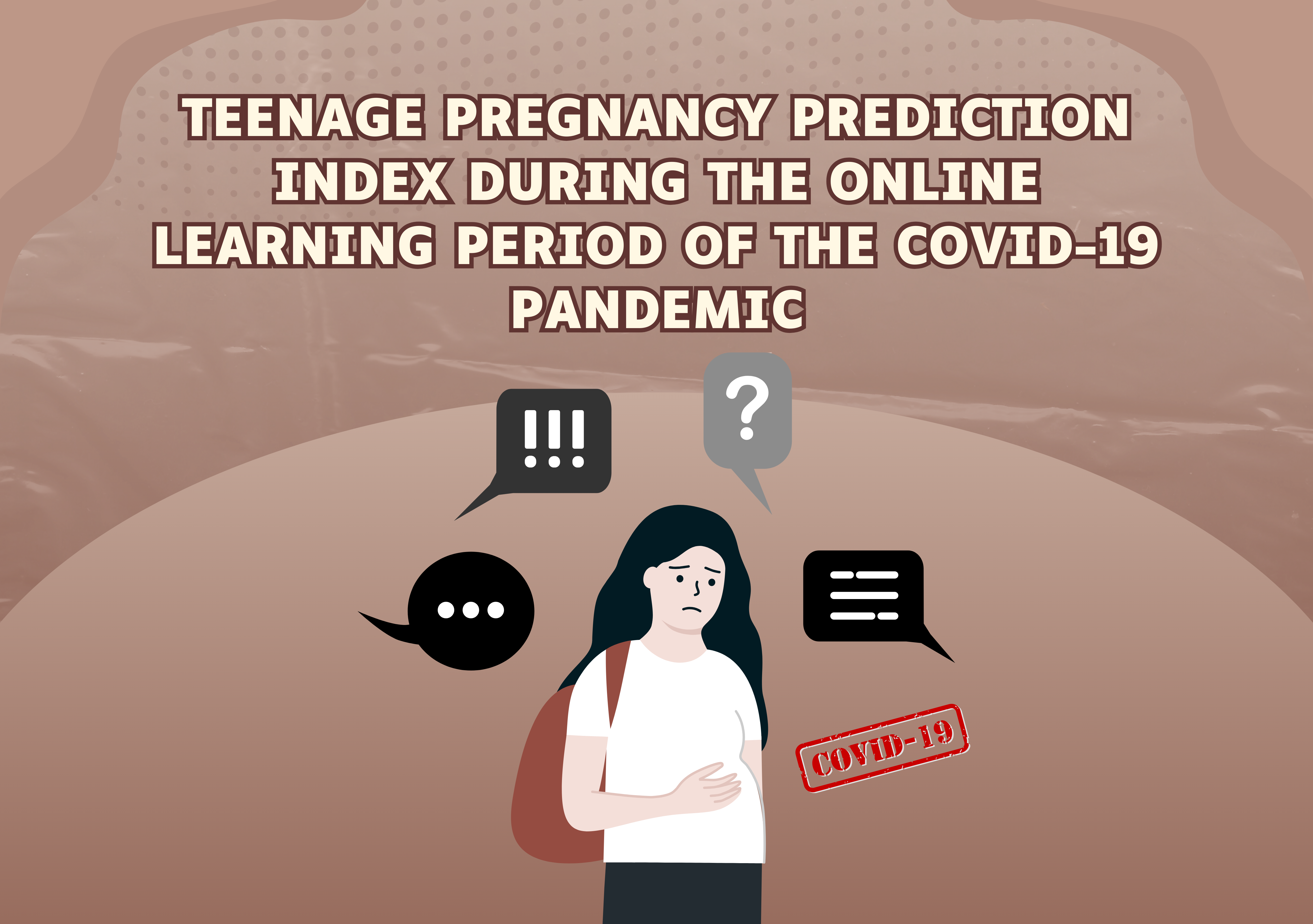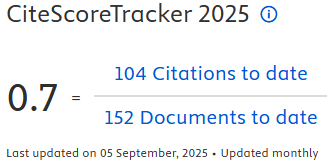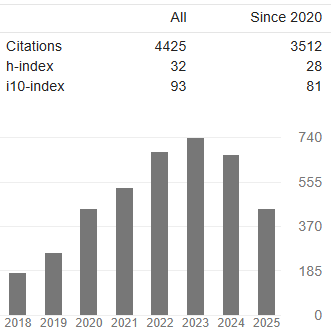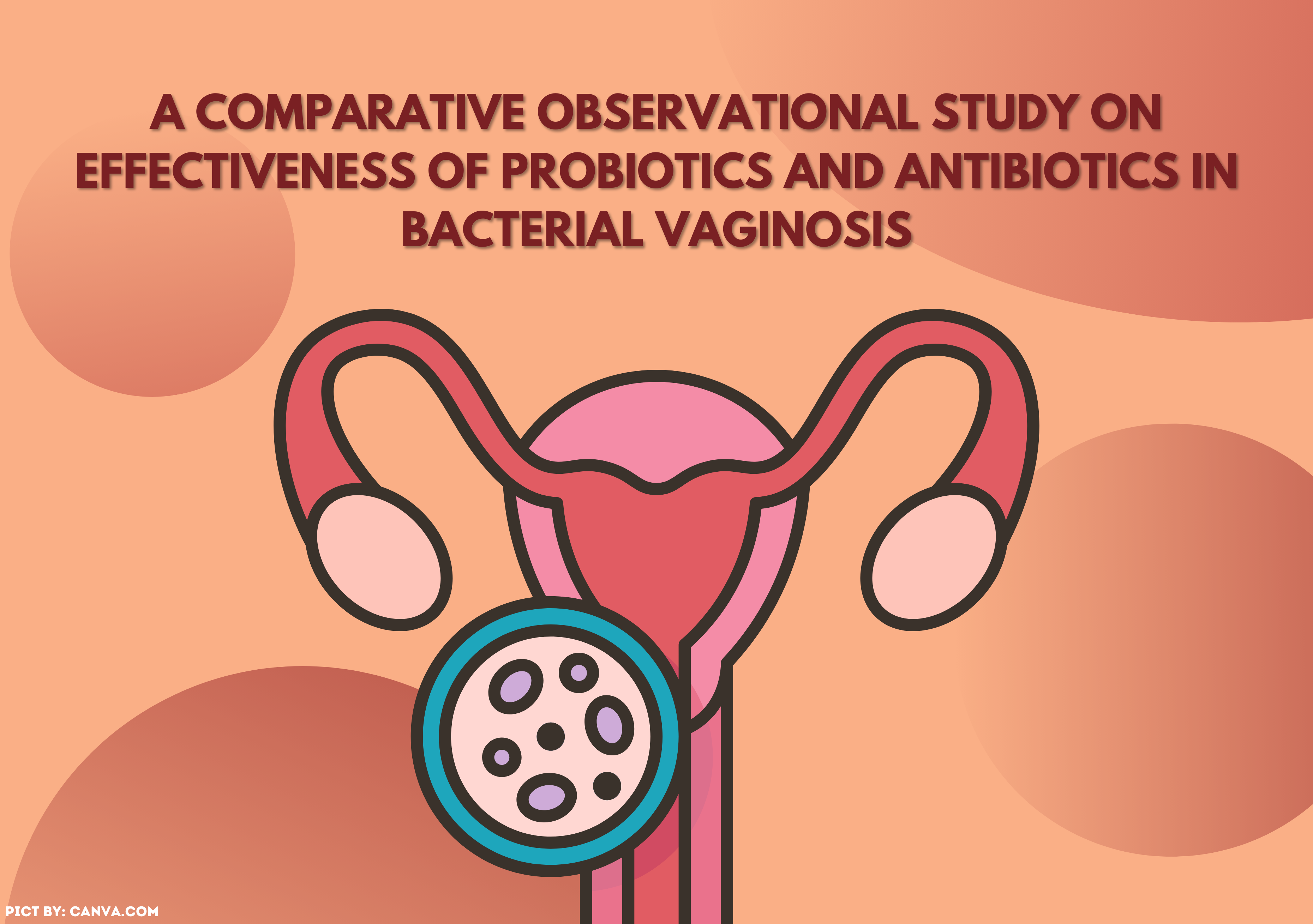TEENAGE PREGNANCY PREDICTION INDEX DURING THE ONLINE LEARNING PERIOD OF THE COVID-19 PANDEMIC

Introduction: The impact of the pandemic on adolescents' lives showed that 55.1% stress and 40% anxiety due to online learning along with an increase in teenage pregnancy. Aims: To determine the predictive index of risk variables for teen pregnancy throughout the COVID-19 pandemic's online learning period. Methods: This type of research is analytic observational utilizing a case-control design. Using simple random sampling, the case sample was 40 pregnant adolescents and 80 non-pregnant controls for the Indonesian Regency of Ngawi from July 2021 until January 2022. Once each variable was significant, multivariable logistic regression analysis was performed (p < 0.05) as predictors of teenage pregnancy. Results: The findings revealed that the variables as indicators of the risk of teenage pregnancy were courtship behavior, access to reproductive health media, and parenting. The predictive index of teen pregnancy risk factors was (-7.248 + 3.833 x low risk dating + 7.726 x severe risk dating + 2.773 x access 1 media + 2.773 x access 2/more media + 3.871 x authoritarian and permissive parenting). The high probability of teenage pregnancy with an opportunity value above 0.5 is in adolescents with dating behavior or parenting patterns that show the highest risk, namely high-risk dating behavior or adolescents with authoritarian and permissive parenting patterns. Conclusion: It is hoped that this index can be considered and used as a measuring tool in assisting in reproductive health programs, in screening adolescents so that it can be known early on that adolescents have an increased risk of pregnancy.
Ahinkorah, B.O. et al. (2021) ‘Prevalence of first adolescent pregnancy and its associated factors in sub-Saharan Africa: A multi-country analysis', PLoS One, 16(2), p. e0246308. https://doi.org/10.1371/journal.pone.0246308
Aryati, H., Suwarni, L. and Ridha, A. (2019) ‘Paparan Pornografi, Sosial Budaya, Dan Peran Orang Tua Dalam PerilakuBarat Berpacaran Remaja Di Kabupaten Sekadau Provinsi Kalimantan', Jurnal Kesmas (Kesehatan Masyarakat) Khatulistiwa, 6(3), pp. 127–136.
Bender, L. (2020) ‘Interim Guidance for COVID-19 Prevention and Control in Schools.', Unicef [Preprint].
Chotimah, K. et al. (2020) ‘Determinants of adolescent first births in Indonesia', Systematic Reviews in Pharmacy, 11(5), pp. 241–245.
Chung, H.W., Kim, E.M. and Lee, J.-E. (2018) ‘Comprehensive understanding of risk and protective factors related to adolescent pregnancy in low-and middle-income countries: A systematic review', Journal of Adolescence, 69, pp. 180–188. https://doi.org/10.1016/j.adolescence.2018.10.007
Díaz-Sánchez, J.P., Lanchimba, C. and Obaco, M. (2021) ‘The association between overcrowded households and adolescent pregnancy', Sexuality research and social policy, 18, pp. 555–563. https://doi.org/10.1007/s13178-020-00480-8
Fauziyyah, R., Awinda, R.C. and Besral, B. (2021) ‘Dampak Pembelajaran Jarak Jauh terhadap Tingkat Stres dan Kecemasan Mahasiswa selama Pandemi COVID-19', Jurnal Biostatistik, Kependudukan, dan Informatika Kesehatan, 1(2), pp. 113–123.
Hart, J.R., Coates, E.E. and Smith-Bynum, M.A. (2019) ‘Parenting style and parent-adolescent relationship quality in African American mother-adolescent dyads', Parenting, 19(4), pp. 318–340. https://doi.org/10.1080/15295192.2019.1642085
Hoskins, D.H. (2014) ‘Consequences of parenting on adolescent outcomes', Societies, 4(3), pp. 506–531. https://doi.org/10.3390/soc4030506
Jianjun, D. et al. (2020) ‘The effect of COVID-19 stress on sexual compulsivity symptom: The mediating role of perceived social support'. https://doi.org/10.21203/rs.3.rs-17956/v1
Kartika, A.A.D. and Budisetyani, I.G.A. (2018) ‘Hubungan pola asuh demokratis dengan perilaku seksual pranikah pada remaja di Denpasar dan Badung', Jurnal Psikologi Udayana, 5(1), pp. 63–71.
Kassa, G.M. et al. (2018) ‘Prevalence and determinants of adolescent pregnancy in Africa: a systematic review and meta-analysis', Reproductive health, 15(1), pp. 1–17. https://doi.org/10.1186/s12978-018-0640-2
Kiani, M.A., Ghazanfarpour, M. and Saeidi, M. (2019) ‘Adolescent pregnancy: a health challenge', International Journal of Pediatrics, 7(7), pp. 9749–9752. https://doi.org/10.22038/ijp.2019.40834.3444
Krisylva, A., Joewono, H.T. and Maramis, M.M. (2019) ‘Faktor yang Memengaruhi Kehamilan Sebelum Menikah Pada Remaja Di Empat Puskesmas Kabupaten Sikka Tahun 2017', Jurnal Keperawatan Muhammadiyah, 4(2).
Lawall, A.R., Tram, J.M. and Kumar, N. (2022) ‘The impact of parenting styles on subsequent parenting styles in sons', The Family Journal, 30(3), pp. 444–449. https://doi.org/10.1177/10664807211052306
Lestari, R.M., Paramita, A. and Bella, B. (2019) ‘Analisis Hubungan Status Ekonomi Dan Budaya Dengan Kejadian Kehamilan Usia Remajadi Puskesmas Pahandut Kota Palangka Raya', in Proceeding Of Sari Mulia University Midwifery National Seminars, pp. 217–224. https://doi.org/10.33859/psmumns.v0i1.45
Levani, Y., Hakam, M.T. and Utama, M.R. (2020) ‘Potensi Adiksi Penggunaan Internet pada Remaja Indonesia di Periode Awal Pandemi Covid 19', Hang Tuah Medical Journal, 17(2), pp. 102–115.
Li, G. et al. (2020) ‘Impact of the COVID-19 pandemic on partner relationships and sexual and reproductive health: cross-sectional, online survey study', Journal of Medical Internet Research, 22(8), p. e20961. doi:10.2196/20961
Lindberg, L.D., Bell, D.L. and Kantor, L.M. (2020) ‘The sexual and reproductive health of adolescents and young adults during the COVID"19 pandemic', Perspectives on Sexual and Reproductive Health [Preprint]. doi: 10.1363/psrh.12151
Liputan 6 (2021) pernikahan-usia-dini-di-ngawi-meningkat-di-masa-pandemi.
Magdalena, E. and Notobroto, H.B. (2016) ‘Pengaruh Aktivitas Seksual Pranikah, Ketaatan Beragama dan Sosial Ekonomi terhadap Kehamilan Remaja di Kecamatan Saptosari Gunungkidul', Jurnal Biometrika dan Kependudukan, 5(1), pp. 19–26.
Meriyani, D.A., Kurniati, D.P.Y. and Januraga, P.P. (2016) ‘Faktor Risiko Kehamilan Usia Remaja di Bali: Penelitian Case Control', Public Health and Preventive Medicine Archive, 4(2), pp. 201–206.
National Population and Family Planning Agency (2018) Survei Demografi dan Kesehatan Indonesia 2017: Buku Remaja, Badan Kependudukan dan Keluarga Berencana Nasional.
National Population and Family Planning Agency of East Java Province (2020) Laporan Kinerja Instansi Pemerintah 2020.
Nelson, K.M. et al. (2020) ‘"Physical Sex Is Over for Now”: impact of COVID-19 on the well-being and sexual health of adolescent sexual minority males in the US', Journal of Adolescent Health, 67(6), pp. 756–762. https://doi.org/10.1016/j.jadohealth.2020.08.027
Nizmadilla, Y. et al. (2020) ‘Peran Remaja Dalam Situasi New Normal The Role Of Youth In New Normal Situations', JAM: JURNAL ABDI MASYARAKAT, 1(1).
Novanti, N., Anasari, T. and Khosidah, A. (2013) ‘Hubungan Pola Asuh Orangtua Dengan Kejadian Kehamilan Diluar Nikah Pada Remaja Di Kecamatan Randudongkal Tahun 2013', Jurnal Kebidanan, 2(2), pp. 50–55. DOI: https://doi.org/10.26714/jk.2.2.2013.50-55
Poudel, S. et al. (2018) ‘Trends and factors associated with pregnancies among adolescent women in Nepal: Pooled analysis of Nepal Demographic and Health Surveys (2006, 2011 and 2016)', PloS One, 13(8), p. e0202107. https://doi.org/10.1371/journal.pone.0202107
Purnamawati, D. and Aritonang, V. (2020) ‘Kehamilan Yang Tidak Diinginkan Pada Remaja; Kekerasan Dalam Berpacaran, Peran Orangtua Dan Sekolah', in Prosiding Forum Ilmiah Tahunan (FIT) IAKMI.
Qomariah, S. (2020) ‘Pacar Berhubungan dengan Perilaku Seks Pranikah pada Remaja', Jurnal Kesmas Asclepius, 2(1), pp. 44–53. https://doi.org/10.31539/jka.v2i1.585
Regent of Ngawi Regency (2021a) ‘Surat Edaran Nomor: 065/07.09/404.011/2021 Tentang Pemberlakuan Pembatasan Kegiatan Masyarakat Darurat Covid-19 di Kabupaten Ngawi', pp. 1–5.
Regent of Ngawi Regency (2021b) ‘Surat Edaran Nomor: 065/08.07/404.011/2021 Tentang Pemberlakuan Pembatasan Kegiatan Masyarakat Level 4 Covid-19 di Kabupaten Ngawi', pp. 1–7.
Rodríguez-Gutiérrez, E., Martín-Quintana, J.C. and Cruz-Sosa, M. (2016) ‘"Living Adolescence in Family” parenting program: Adaptation and implementation in social and school contexts', Psychosocial Intervention, 25(2), pp. 103–110. https://doi.org/10.1016/j.psi.2016.03.004
SDGs Center Universitas Airlangga (2021) Sustainable Development Goals Guidelines. Surabaya.
Seage, S.J. and Türegün, M. (2020) ‘The Effects of Blended Learning on STEM Achievement of Elementary School Students.', International Journal of Research in Education and Science, 6(1), pp. 133–140.
Setyaningsih, M.M. and Sutiyarsih, E. (2020) ‘Faktor-Faktor Determinan yang melatar belakangi Kehamilan Remaja di Desa Pandansari Kecamatan Poncokusumo Kabupaten Malang', Jurnal Ners dan Kebidanan (Journal of Nursing and Midwifery), 7(2), pp. 247–255. DOI: 10.26699/jnk.v7i2.ART.p247–255
Smith, C. (2018) ‘Family, academic, and peer group predictors of adolescent pregnancy expectations and young adult childbearing', Journal of Family Issues, 39(4), pp. 1008–1029. https://doi.org/10.1177/0192513X16684894
Suryani, S., Sriati, A. and Septiani, N. (2020) ‘Lived experiences of adolescents with internet addiction', Nurse Media Journal of Nursing, 10(2), pp. 158–170. DOI: 10.14710/nmjn.v10i2.31161
Suryatama, H. et al. (2019) ‘Urinary Cotinine and Expired CO Concentrations in Women Exposed to Environmental Tobacco Smoke at Home', Jurnal Respirologi Indonesia, 39(3), pp. 140–153.
Svanemyr, J. (2020) ‘Adolescent pregnancy and social norms in Zambia', Culture, Health & Sexuality, 22(6), pp. 615–629. https://doi.org/10.1080/13691058.2019.1621379
Tartari, E. (2015) ‘Benefits and risks of children and adolescents using social media', European Scientific Journal, 11(13).
The Indonesian Ministry of Health (2020) Pedoman Pelayanan Kesehatan Anak Usia Sekolah dan Remaja di Masa Pandemi COVID-19.
The Indonesian Ministry of Health (2021) Profil Kesehatan Indonesia 2020, Kementerian Kesehatan RI.
The Ministry of National Development Planning of The Republic of Indonesia (2020) Pedoman Teknis Penyusunan Rencana Aksi Tujuan Pembangunan Berkelanjutan (Tpb)/ Sustainable Development Goals (SDGs), Pedoman Teknis Penyusunan Rencana Aksi - Edisi II Tujuan Pembangunan Berkelanjutan/ Sustainable DEVELOPMENT GOALS (TPB/SDGs).
The Statistical Center of Ngawi District (2019) Jumlah Usia Kawin Pertama di Kabupaten Ngawi, 2019.
Vincent, G. and Alemu, F.M. (2016) ‘Factors contributing to, and effects of, teenage pregnancy in Juba', South Sudan Medical Journal, 9(2), pp. 28–31.
WHO (2020) ‘Adolescent Pregnancy'. pregnancy.
Widman, L. et al. (2018) ‘Technology-based interventions to reduce sexually transmitted infections and unintended pregnancy among youth', Journal of Adolescent Health, 62(6), pp. 651–660. https://doi.org/10.1016/j.jadohealth.2018.02.007
Worku, M.G. et al. (2021) ‘Prevalence and associated factors of adolescent pregnancy (15–19 years) in East Africa: a multilevel analysis', BMC Pregnancy and Childbirth, 21, pp. 1–8. https://doi.org/10.1186/s12884-021-03713-9
Yukich, J. et al. (2021) ‘Projecting the impact of the COVID-19 pandemic on child marriage', Journal of Adolescent Health, 69(6), pp. S23–S30. https://doi.org/10.1016/j.jadohealth.2021.07.037
Zulaika, G. et al. (2022) ‘Impact of COVID-19 lockdowns on adolescent pregnancy and school dropout among secondary schoolgirls in Kenya', BMJ Global Health, 7(1), p. e007666. http://dx.doi.org/10.1136/bmjgh-2021-007666
Copyright (c) 2024 The Indonesian Journal of Public Health

This work is licensed under a Creative Commons Attribution-NonCommercial-ShareAlike 4.0 International License.
- The authors agree to transfer the transfer copyright of the article to The Indonesian Journal of Public Health effective if and when the paper is accepted for publication.
- Authors and other parties are bound to the Creative Commons Attribution-NonCommercial-ShareAlike 4.0 International License for the published articles, legal formal aspect of journal publication accessibility refers to Creative Commons Attribution-NonCommercial-ShareAlike 4.0 International License (CC BY-NC-SA), implies that:
- Attribution ” You must give appropriate credit, provide a link to the license, and indicate if changes were made. You may do so in any reasonable manner, but not in any way that suggests the licensor endorses you or your use.
- NonCommercial ” You may not use the material for commercial purposes.
- ShareAlike ” If you remix, transform, or build upon the material, you must distribute your contributions under the same license as the original.































